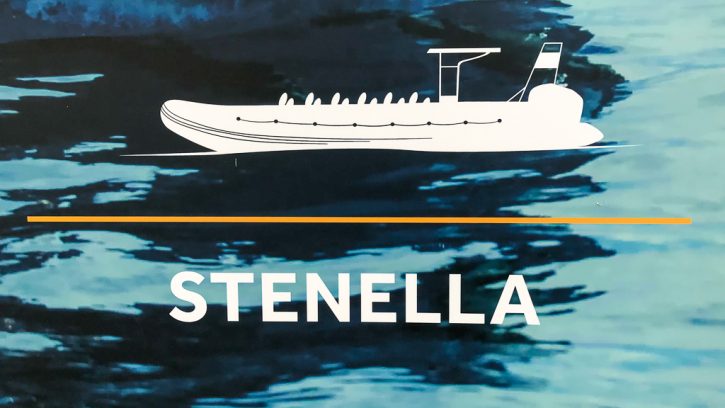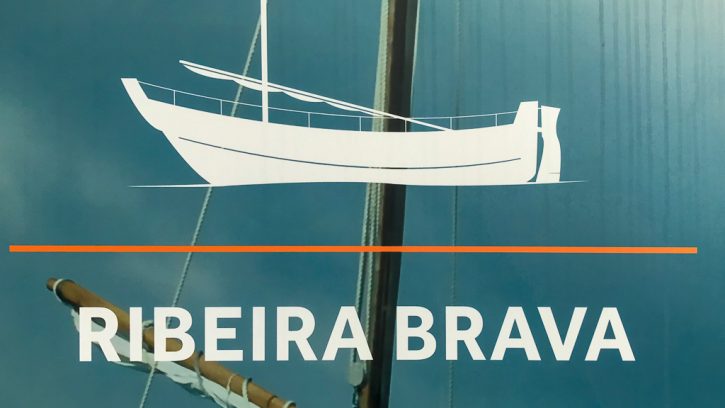“Where the blue of the sea meets the sky”, in Madeira
It’s a beautiful day in Madeira. I’m heading to Calheta in the south-west of the Island; I’m staying in the north-west of the Island. Next time I’ll pay more attention to geography. At least I made the right decision in falling for the hire-car upselling, as the open-top Fiat 500 has been great fun, apart from being woefully underpowered on all those slopes, but then, so am I.
It’s a three hour boat trip. All the parking spaces are for two hours maximum. I abandon the car on the pavement in a classic example of the sort of Italian ‘wild parking’ of which the Puffin Whisperer would be proud. Parcheggio selvaggio. It’s our dystopian future, today.
Just look at the multi-layered fabulousness of that sky:
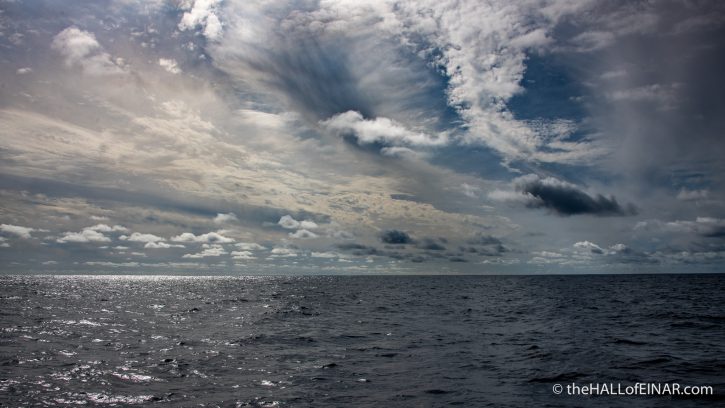
I’m setting off into the Atlantic with Lobosonda, a local whale watching tour company. I’ve already been out with them this week, on a fast boat, the Stenella, a 12-person speedboat. This time it’s a more sedate trip on the Ribeira Brava, a traditional fishing boat which has space for 16.
The weather’s beautiful and the punters are enthusiastic. There’s a 30 minute arrival time so we can all have the health and safety briefing. It’s going to be in German first. I explain that “Ich spreche kein Deutsch”, in my best German accent, which makes all the German tourists laugh. Those English and their quirky sense of humour. All the Germans were there first and they’ve taken all the seats. There are just two more people to join us. They are Italians. They are late. One of them is still trying to find somewhere to park. She appears eventually, having abandoned her car on the pavement somewhere in a classic case of parcheggio selvaggio.
We’re soon out into the Atlantic and see Bottlenose Dolphins, Tursiops truncatus, the species which is out here all year round. Aren’t they fabulous?
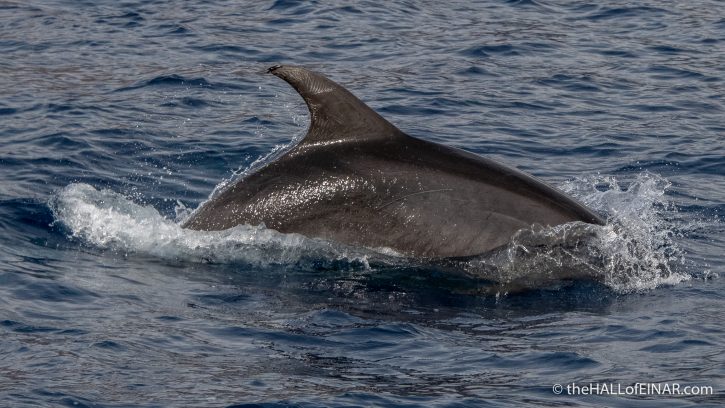
It’s not the sharpest photo, but it does show a calf riding next to an adult.
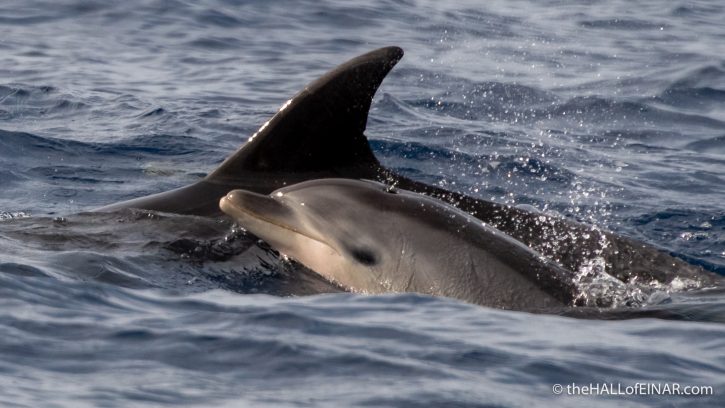
It’s hard to tell how many there are here.
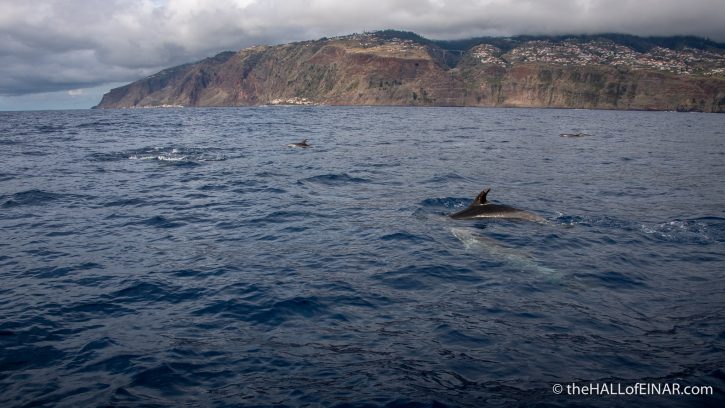
One comes so close I can see it breathing out, or, as it’s known by humans, sneezing.
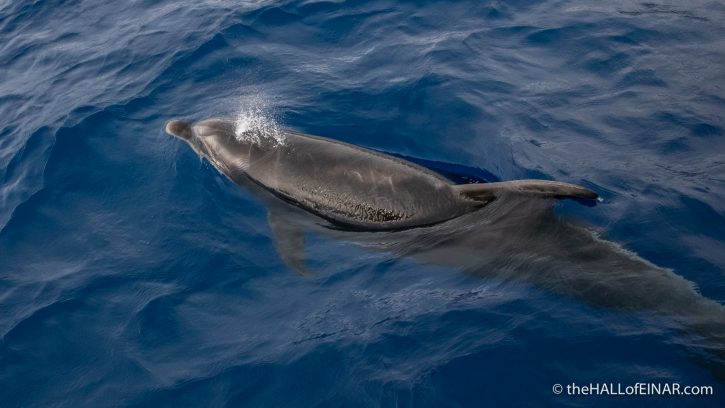
I love this shot of the calf having a good look above water:
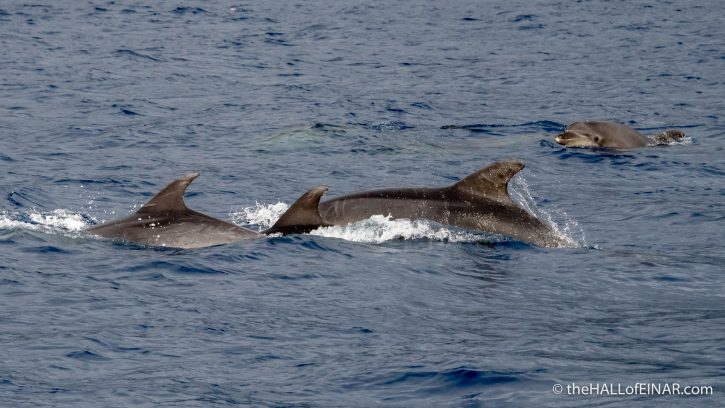
They are so incredibly smooth, the friction of the water must be minimised to help them glide, seemingly effortlessly:
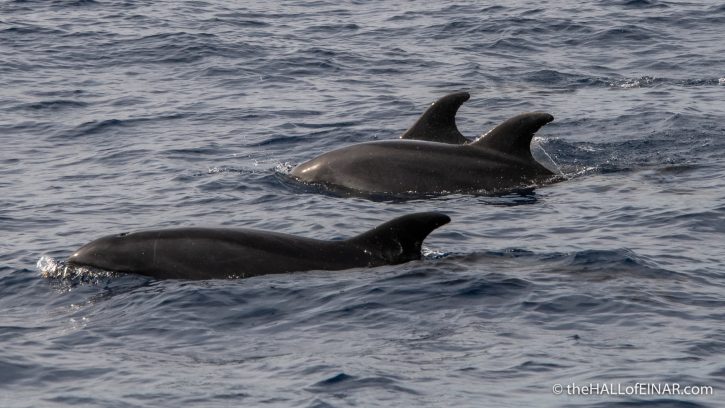
Having said that, they’re full of bite marks. There are traces of multiple engraved parallel gouges on their faces, sides and especially on their dorsal fins.
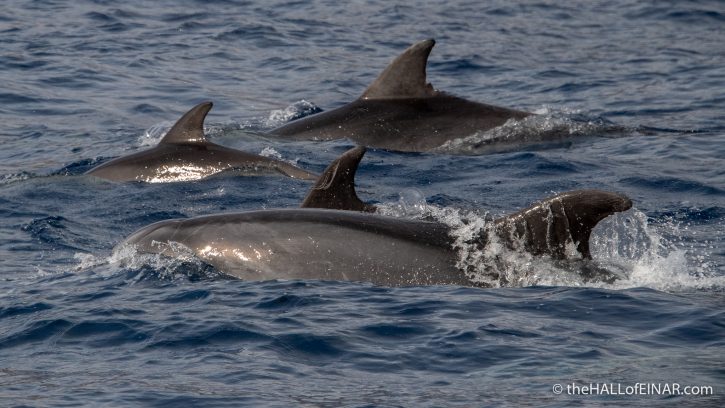
They’ve either been playing, fighting or courting, I’m not sure which.
It’s great to see fins breaking the surface.
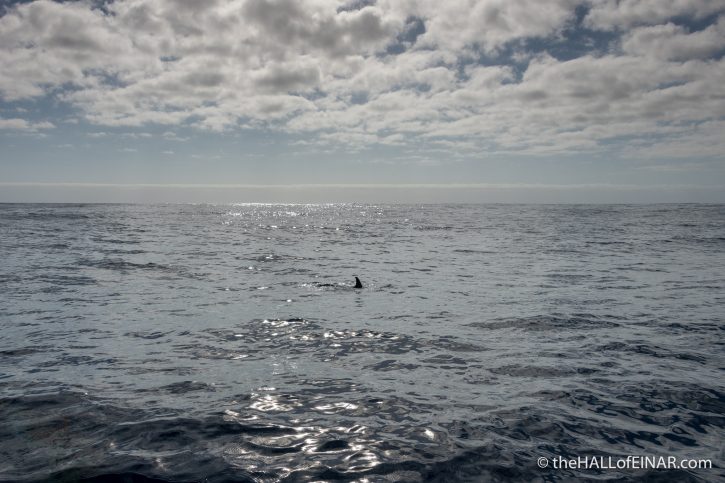
I studied dolphin haemoglobin for fun when I was 17. They have remarkable adaptations in their blood which allow them to function when their blood turns acidic like fizzy water, with all that carbon dioxide in it, and no place to get rid of it until they surface and have a good sneeze.
Our guide, Filipe, starts talking to me fast in German. He heard me speak it earlier. That’ll teach me to attempt humour.
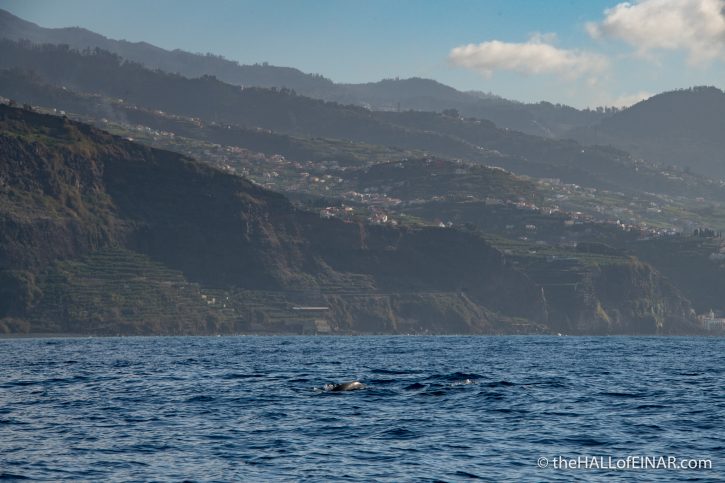
We are in the hands of a team of three, a spotter on the cliffs, looking for signs, a captain steering the ship and a multi-lingual marine biologist explaining our finds and the life of the ocean.
As well as the Bottlenose Dolphins there are Common Dolphins, Delphinus delphis, here too.
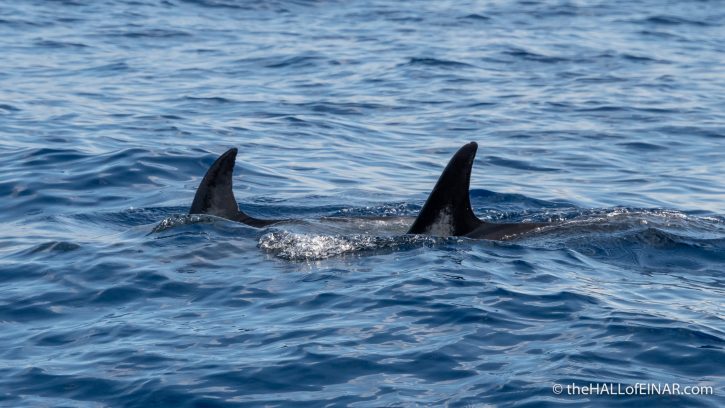
These don’t seem to have bitten each other, at least if they do, they don’t leave a mark.
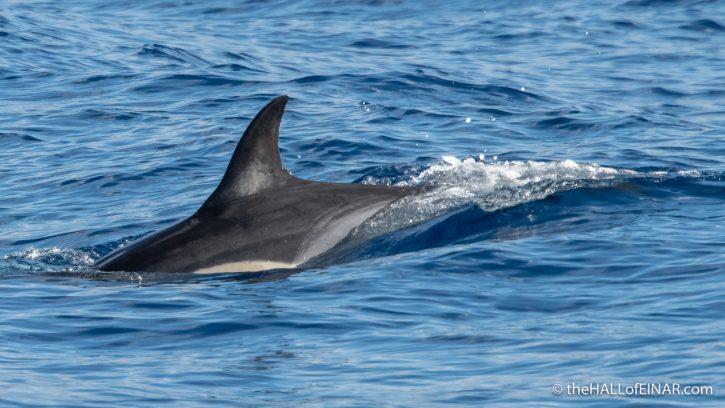
Back on land I sit and look at the back of my camera and I’m feeling quite emotional looking at the face of the calf. I’m stopped from imminent crying by a German couple who chat. They are here for the whales and dolphins. They tell me all about their pilgrimages to the Azores. I must go there.
As I sit on the beach I take a photograph of a wave breaking on the volcanic rock boulders of the beach. It’s in colour, although you wouldn’t be able to guess that from the end result.
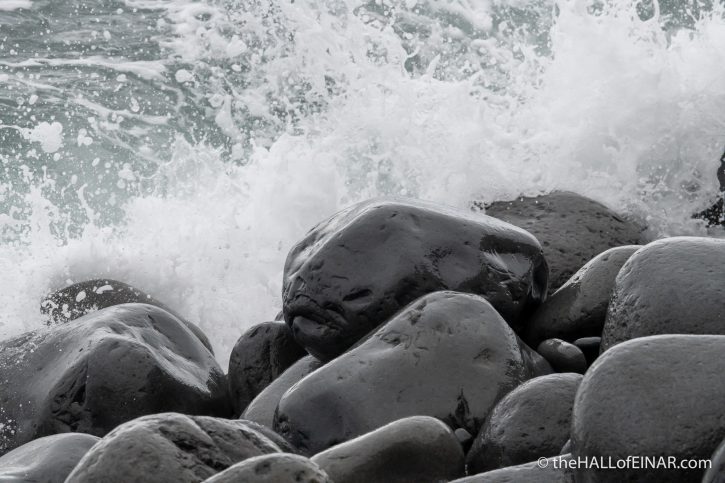
If you’ve enjoyed reading about and seeing my trip, perhaps you would take some time to support worthwhile causes, fighting for dolphin protection:
- Save Japan’s dolphins in Taiji
- Boycott Tokyo 2020 Olympics
- Close all dolphinaria in Europe
- Stop hunting whales
- Empty Seaworld’s tanks
As usual with my blog, I paid in full for my experience and have no reason to tell you anything other than my honest opinion.
Back at the house it’s time to cook and listen to some music. Here’s Johnny Flynn and Laura Marling singing The Water so beautifully, in exquisite harmony. It’s a song which people seem incapable of understanding the meaning of.
Now deeper the water I sail
And faster the current I’m in
That each night brings the stars
And the song in my heart
Is a tune for the journeyman’s tale
The water sustains me without even trying
The water can’t drown me, I’m done
With my dying
If you check any song meanings website it’ll be full of literal interpretations about water and streams and drowning, without any hint that water might be a metaphor. All you have to do is substitute “the love of God” instead of “the water” and you get the real meaning of the song.
Personally, I’d substitute “the love of nature”.
Now the land that I knew is a dream
And the line on the distance grows faint
So wide is my river
The horizon a sliver
The artist has run out of paint
Where the blue of the sea meets the sky
And the big yellow sun leads me home
I’m everywhere now
The way is a vow
To the wind of each breath by and by
The water sustains me without even trying
The water can’t drown me, I’m done
With my dying
“The love of nature sustains me
without even trying“
More Madeira
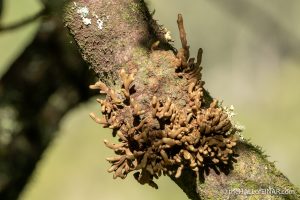 Laurel fungus in Madeira Here's a find from when it was possible to travel There's a fungus on this laurel tree: It's Laurobasidium lauri,… read more
Laurel fungus in Madeira Here's a find from when it was possible to travel There's a fungus on this laurel tree: It's Laurobasidium lauri,… read more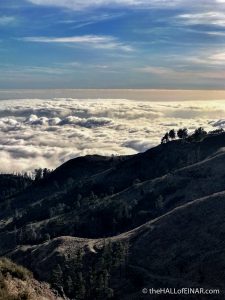 The Madeira outtakes On the way to Madeira I sit next to a couple and they chat. I say 'they' chat, when I… read more
The Madeira outtakes On the way to Madeira I sit next to a couple and they chat. I say 'they' chat, when I… read more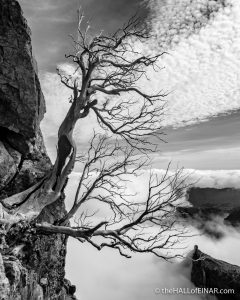 Clinging on At 1,800m the clouds are below me and above me on Madeira. I'm a cloud sandwich. On the slopes is… read more
Clinging on At 1,800m the clouds are below me and above me on Madeira. I'm a cloud sandwich. On the slopes is… read more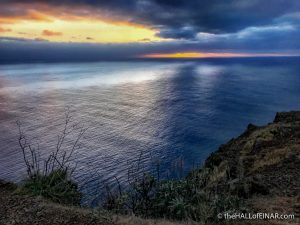 Fire and water I'm off on a trip to the far west of Madeira. There's a lighthouse at Ponto do Pargo which sounds… read more
Fire and water I'm off on a trip to the far west of Madeira. There's a lighthouse at Ponto do Pargo which sounds… read more There once was an ugly duck. A very ugly duck. You know the story. There's an ugly duckling which turns into a swan. I don't need to go all Hans… read more
There once was an ugly duck. A very ugly duck. You know the story. There's an ugly duckling which turns into a swan. I don't need to go all Hans… read more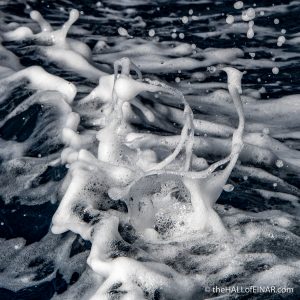 Skum Have you ever looked at a fire extinguisher in Denmark? No? Can I say that I'm not surprised? If you… read more
Skum Have you ever looked at a fire extinguisher in Denmark? No? Can I say that I'm not surprised? If you… read more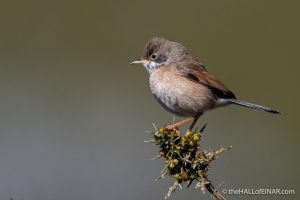 Madeira birdwatching with Luis Dias There's another birdwatching business on Madeira. It's called Birds and Company. I would give you a link to their website,… read more
Madeira birdwatching with Luis Dias There's another birdwatching business on Madeira. It's called Birds and Company. I would give you a link to their website,… read more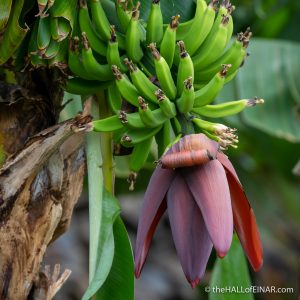 Yes! we have no bananas I'm in Calheta in Madeira for the afternoon. Behind the road following the coast is a large garden which appears… read more
Yes! we have no bananas I'm in Calheta in Madeira for the afternoon. Behind the road following the coast is a large garden which appears… read more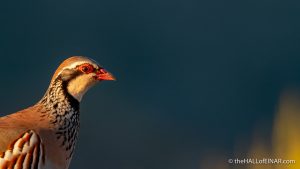 Red-Legged Partridge up the mountain I'm standing bathing in the cold orange light of sunset when I spot a largish bird walking towards me. I… read more
Red-Legged Partridge up the mountain I'm standing bathing in the cold orange light of sunset when I spot a largish bird walking towards me. I… read more